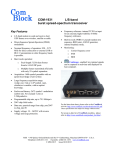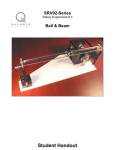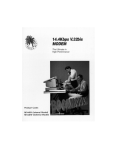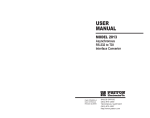Download Fax Operation
Transcript
Chapter 9 Fax Operation GENERAL The V.3400 can send and receive fax documents at speeds up to 14400 bps when used with the appropriate software. As a fax modem, the modem conforms to EIA-578 which defines a standard interface between the DTE (a PC with fax software) and the DCE as a fax modem. When used with a Class 1 fax software package, V.3400 is CCITT Group 3 compatible and can send and receive documents at 2400, 4800, 7200, 9600, 12000, or 14400 bps with any Group 3 fax machine or PC with a fax modem. Service Class selection configures the modem for Class 0 data mode or Class 1 fax mode. The LCD display indicates when fax mode is enabled. The V.3400 default configuration is for data mode; Service Class is normally only changed by the software as necessary. Previous chapters in this manual contain information about the modem that should be understood prior to fax operation. Those chapters should be read before this chapter. Users should understand the fax software manual before attempting fax communications. FAX OPERATION The user's manual for the Class 1 fax software package should provide most information necessary to configure the software and send and receive faxes. The information in Chapter 2 of this manual should be considered as well, and also the next section of this chapter provides important information for proper fax communications. V.3400 9-1 Fax Operation MODEM INITIALIZATION For fax operation, most fax software packages are equipped with a fax initialization command string. Entering this command sets the active profile for fax operation. In some cases certain options should be modified for particular requirements. The fax software manual provides information about requirements. FAX DEFAULTS Factory defaults along with the initialization command support fax operation. Some initialization commands include the default command &F and will reissue it for each fax operation. Users must be aware that some fax software packages do not include the default command or only issue the default command when the fax software is first loaded. Subsequent fax operations may not reset the fax profile and if a fax required option has been changed by the user fax operation will not work. An example of a fax initialization command is AT&F V E S0=0 This can be interpreted as: AT&F Reset the active profile to the factory default. V Set response messages to digit code. E Disable local echo (off). S0=0 Disable autoanswer (off). Fax Autoanswer Some fax software takes control of autoanswer, disables autoanswer for the modem, and answers the phone as internally programmed. Other programs do not control autoanswer at all and require the modem to have autoanswer enabled. The user must check the software manual for the particular requirements and refer to Chapter 4 for manual/autoanswer and TALK/DATA selection. Select the necessary options for fax operation. 9-2 V.3400 Fax Operation FAX ASSOCIATED OPTIONS A number of options can be changed without any effect on fax operation. These include items like speaker volume and pause for carrier. Appendix E lists the AT commands and indicates how they may affect fax operation. These commands can be incorporated by personal preference into the initialization command. The user should compare fax operation requirements with Appendix A and if necessary generate an initialization command string compatible with the software and the modem. Stored FAX Profile Another alternative is to develop a fax initialization command and store it in one of the user defined profiles. Fax initialization would include the command that recalls that profile for fax operation. The user must keep track of option changes between fax transmissions and if required reset the fax profile for the next fax transmission. CLASS 1 DETAILS Operation as a fax modem complies with EIA-578; details of Class 1 operation and compatibility are found in that standard. There is no need to be familiar with these details since they are handled by the Class 1 software package, but this section briefly summarizes some of them. As a Service Class 1 facsimile DCE, the V.3400 provides the basic services required to support Group 3 facsimile operation. Support from a Class 1 facsimile DTE is required to implement the CCITT T.30 recommendations for fax document transmission and the CCITT T.4 recommendations for encoding fax images. Using software control the modem can • • • • • connect calls generate messages detect waiting and silence transmit and receive data provide HDLC data framing, transparency, and error detection The modem also filters data streams to and from the DTE in accordance with the Class 1 specification. V.3400 9-3 Fax Operation The Class 1 standard assumes a serial asynchronous DTE-DCE connection using EIA-232D (or CCITT V.24) circuits. EIA-232D circuits AB (signal ground), BA (transmitted data), and BB (received data) are required for fax operation, while additional circuits are optional. Refer to Chapter 2 for hardware installation and EIA-232D data interface information. The modem uses inband unidirectional DC1/DC3 (XON/XOFF) flow control to match the DTE-DCE data rate to the line signaling rate (hardware RTS/CTS is optional). Since 1200 bps is the minimum rate needed to support T.30 Phase C data transfer using V.29 9600 bps, a serial port data rate of at least 19200 bps should be used with the modem. Since flow control is used, this rate should not be changed during fax operation. The modem detects the DTE-DCE data rate from the AT command prefix as described in Chapter 5. CLASS 1 COMMANDS The commands in this section are normally issued by the fax software and not by the user. They are provided here for reference. While only the lower order 7 bits of each character are used for commands and parameters, Phase C data transmission or reception requires all 8 data bits. Therefore, a data format which uses 8 data bits should be used for fax mode. Dial Command D The dial command D, described in Chapter 5, tells the modem to go off hook, dial, and begin call origination. For fax operation, set the modem for Service Class 1 operation before the dial command is issued; use the +FCLASS=1 command. The dial modifier, except R, can also be used in fax mode. Depending on the X option selected, the modem will return the BUSY and NO DIALTONE result codes as appropriate. If the modem is in the online command state when a dial command is issued (e.g., a connection has already been established), the modem returns an ERROR result code. The NO CARRIER result code indicates that a connection could not be established (no carrier detected) within the number of seconds specified in status register S7, or the dial command has been aborted due to a character sent from the DTE. 9-4 V.3400 Fax Operation After dialing the specified number in fax mode, the modem generates 1100 Hz CNG tones in accordance with T.30 while trying to detect either CED (answer back tone) or the HDLC preamble of the first T.30 frame. The CNG tones cease after detecting either of these two signals. To allow proper interaction with manually answered fax stations, detection of CED is not required. After detecting 1650 Hz (i.e., the HDLC preamble of the first frame), the modem enters V.21 Channel 2 receive state with HDLC framing and returns a CONNECT result code. This is because dialing in fax mode (+FCLASS=1) implies an initial +FRH=3 command described later in this section. Answer Command A The A command instructs the modem to answer the call. For fax operation, set the modem for Service Class 1 operation before the A command is issued; use the +FCLASS=1 command. If the modem is in the online command state when an answer command is issued (e.g., a connection is already established), modem returns an ERROR result code. Otherwise, it answers the call and generates a 2100 Hz CED (answer back) tone in accordance with T.30. The modem then enters V.21 Channel 2 transmit state with HDLC framing and returns a CONNECT result code. This is because answering a call in fax mode (+FCLASS=1) implies an initial +FTH=3 command described later in this section. In accordance with T.30, to allow proper interaction with a manually originated fax call, the modem does not require detection of CNG before generating CED or entering HDLC transmit mode. If the DTE sends a character while executing the answer command and before CED is completed, the call is released and the modem will send the NO CARRIER result code. On Hook H In fax mode, the H command instructs the modem to stop any transmission and terminate the call by going on hook. V.3400 9-5 Fax Operation Off Hook H1 The H1 command instructs the modem to go off hook. In fax mode, this might be used when the user has used manual dialing to place a fax call. In this case, no CNG tones are generated and the initial +FRH=3 is not implied; it must be explicitly issued by the software. Class 0 Operation +FCLASS=0 Setting the Service Class to 0 with the +FCLASS=0 command sets the modem in data mode. This default setting is normally only changed by software if needed. Class 1 Operation +FCLASS=1 Setting the Service Class to 1 with the +FCLASS=1 command configures the modem as a Class 1 fax modem. This command is normally only issued by the fax software if needed. When set, the LCD displays FAX CLASS 1 MODE. Service Class Indication +FCLASS? The current Service Class setting can be determined with the +FCLASS? command. A 0 response indicates the modem is configured for data mode while a 1 indicates it is set for fax mode. This information text is preceded and followed by <CR><LF> in addition to being followed by an appropriate result code response. Service Class Capabilities +FCLASS=? The available Service Classes can be revealed by the +FCLASS=? command. The modem responds with the information text 0, 1 (preceded and followed by <CR> <LF>), indicating that the modem supports both data communication and Class 1 fax operation. Transmit Silence +FTS= (Time) The command +FTS=(Time) causes the modem to wait in silence for the specified amount of time and then send the OK result code to the DTE. The (Time) value is in 10 ms increments from 0 to 2.55 seconds. The modem aborts the command and sends an OK result code if the DTE sends an additional character, which is discarded, during the command execution. This command returns an ERROR result code if issued while the modem is on hook. 9-6 V.3400 Fax Operation Receive Silence +FRS=(Time) The command +FRS= causes the modem to listen for silence and report back an OK result code when the line has been silent for the specified amount of time. The (Time) value is in 10 ms increments from 0 to 2.55 seconds. The modem aborts the command and sends an OK result code if the DTE sends an additional character, which is discarded, during the command execution. This command returns an ERROR result code if issued while the modem is on hook. Fax Transmit and Receive Modes The following commands instruct the modem to transmit or receive facsimile data with the designated modulation. Flow control, data buffering, and data filtering are used as appropriate, in accordance with the Class 1 specification. Each of these commands must be the last command on the command line. Command Description +FTM=(MOD) Transmit data with (MOD) carrier +FRM=(MOD) Receive data with (MOD) carrier +FTH=(MOD) Transmit HDLC data with (MOD) carrier +FRH=(MOD) Receive HDLC data with (MOD) carrier The modem accepts one of the values listed in Table 9-1. Table 9-1. Modulation Values Value Modulation Speed 3 V.21 channel 2 300 bps 24 V.27 ter 2400 bps 48 V.27 ter 4800 bps 72 V.29 7200 bps 73 V.17 7200 bps 74 V.17 7200 bps * 96 V.29 9600 bps 97 V.17 9600 bps V.3400 9-7 Fax Operation Table 9-1. Modulation Values (Continued) Value Modulation Speed 98 V.17 9600 bps * 121 V.17 12000 bps 122 V.17 12000 bps * 145 V.17 14400 bps 146 V.17 14400 bps* * with short train The V.3400 returns an ERROR result code if any of the above commands are issued while the modem is on hook. Facsimile Transmit +FTM=(Mod) +FTM= (Mod) causes the modem to transmit data using the modulation and speed selected with the (Mod) parameter. For V.27 ter, V.29, and V.17 modulations, the modem first transmits the required training sequence (with echo protector tone). After it is appropriately configured for transmission, the modem returns the CONNECT result code and transmits constant 1 bits until data is received from the DTE. For additional information, consult the Class 1 specification. Facsimile Receive +FRM=(Mod) +FRM= (Mod) causes the modem to receive data using the modulation and speed selected with the (Mod) parameter. If the selected carrier is detected, a CONNECT result code is sent to the DTE; if a different signal is detected, the modem sends a +FCERROR (CONNECT ERROR) result code and returns to command mode. This command is aborted if the DTE sends any character to the modem other than DC1 or DC3 during this mode. For additional information, consult the Class 1 specification. HDLC Transmit +FTH=(Mod) +FTH=(Mod) causes the modem to transmit HDLC framed data using the modulation and speed selected with the (Mod) parameter. For V.27 ter, V.29, and V.17 modulations, the modem will first transmit the required training sequence (with echo protector tone). Configured for HDLC transmission, the modem transmits HDLC flags and returns the 9-8 V.3400 Fax Operation CONNECT result code. HDLC flags will continue to be sent until the first byte of data is received from the DTE or until 5 seconds elapses with no data. For additional information, refer the Class 1 specification. HDLC Receive +FRH=(Mod) The command +FRH= (Mod) causes the modem to receive HDLC framed data using the modulation and speed selected with the (Mod) parameter. If the selected carrier is detected, a CONNECT result code is sent to the DTE; if a different signal is detected, the modem sends a +FCERROR (CONNECT ERROR) result code and returns to command mode. This command will be aborted if the DTE sends any character to the modem other than DC1 or DC3 during this mode. For additional information, consult the Class 1 specification. Test Supported Range of Values +FTx=?, +FRx=? The supported range of values for any of the fax transmit or receive commands can be determined with the +FTx=? or +FRx=? command where x is M, H, or S. The normal transmit and receive capabilities are interrogated with +FTM=? and +FRM=?, while the HDLC transmit and receive capabilities are interrogated with +FTH=? and +FRH=?. Since the modem can send and receive normal data or HDLC data at all valid speeds up to 14400 bps, the modem returns the information text 3, 24, 48, 72, 73, 74, 96, 97, 98, 121, 122, 145, 146 for any of these four commands if x is M or H. For the commands +FTS=? or +FRS=? the modem returns the information text 0-255, indicating an allowed time interval from 0 to 2.55 seconds. The appropriate information text is always preceded and followed by <CR><LF> and followed by an appropriate result code response. Class 1 Result Code +FCERROR If the modem detects any carrier or tone that differs from that specified in a +FRM or +FRH command, it sends the +FCERROR result code and returns to command state, allowing the DTE to attempt a recovery. The numeric form of this response is +F4. V.3400 9-9 Fax Operation Fax Auto Answer +FAA= The modem can be set up to automatically detect if a fax or data call is being answered. The command +FAA=1 enables this function and +FAA=0 disables it. This feature requires special support by the fax software package. Command Description +FAA=0 Disable fax auto answer +FAA=1 Enable fax auto answer BINARY FILE TRANSFER Some Class 1 software packages may provide an option for transferring files between computers with fax modems, using a Binary File Transfer (BFT) standard. Although the received file is not a fax image, transmitting the file is similar to sending a fax. Since the modem allows T.30 error correction mode (with HDLC framing up to 9600 bps), fax mode can also be used for BFT if supported by the Class 1 software package. The Binary File Transfer is an option in the fax software package, not a separate mode of operation. 9-10 V.3400
















